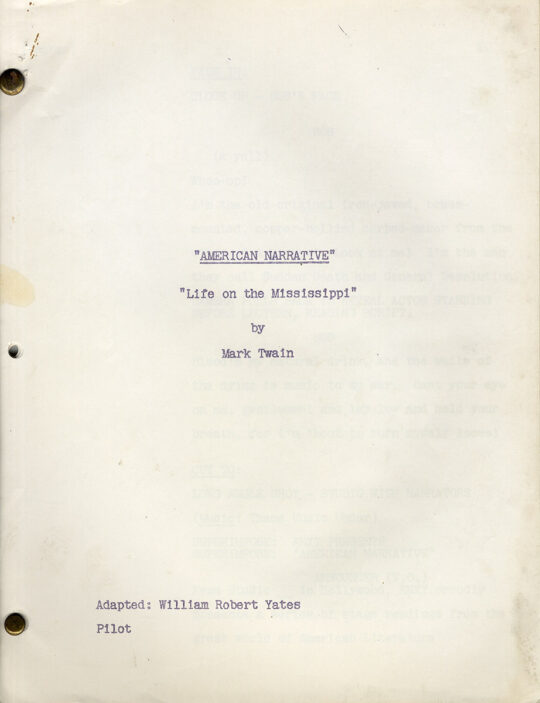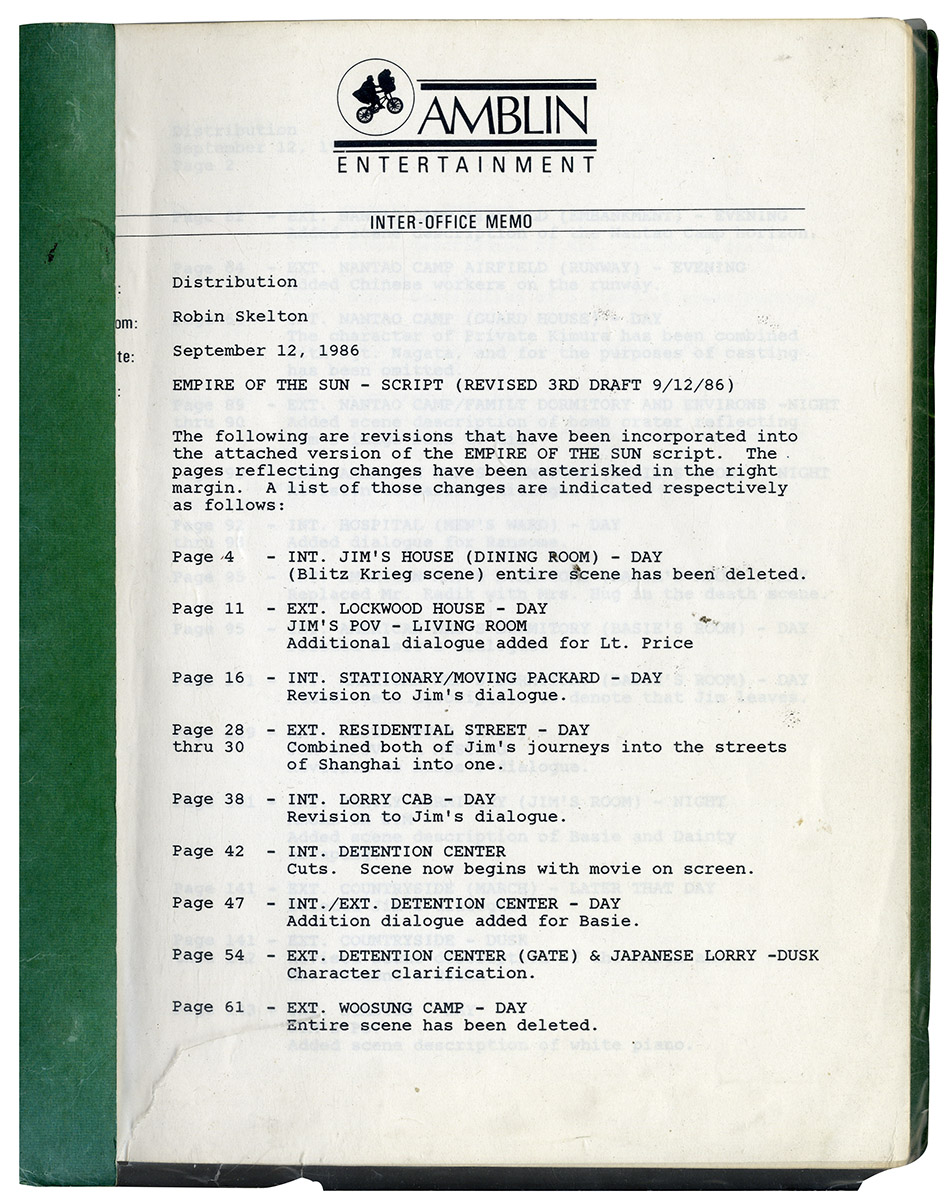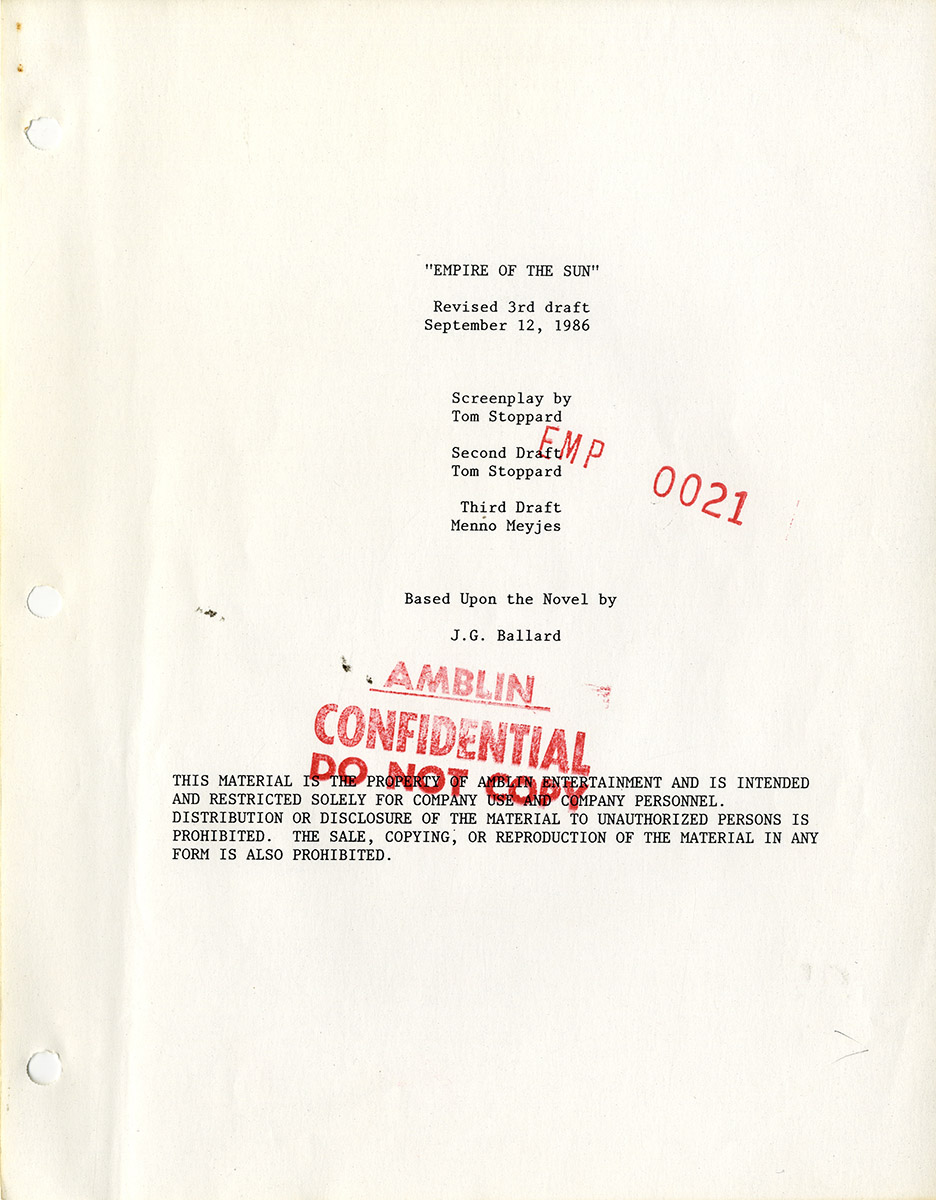J. G. Ballard (source), Tom Stoppard, Menno Meyjes (screenplay), Steven Spielberg (director) EMPIRE OF THE SUN (Sep 12, 1986) Revised Third Draft screenplay
[Los Angeles]; Amblin Entertainment, 1986. Vintage original film script, 11 x 8 1/2″ (28 x 22 cm.), [4], 162 pp. Designated as Third Draft, credited by Meyjes, and with credits to Stoppard for the screenplay and its previous Second Draft. Brad bound, with clear glassine wrappers (torn) at front and blank green wrappers at back. Overall just about fine in very good wrappers.
Empire of the Sun was J. G. Ballard’s autobiographical novel, published in 1984, based largely on Ballard’s experiences as a young boy imprisoned in a Japanese internment camp during World War II. Although the movie version was originally intended to be directed by David Lean with Steven Spielberg acting as producer, artistic differences between Lean and Spielberg led to Spielberg taking over the direction. Reflecting Spielberg’s affinity for coming-of-age stories and his fascination with aviation and World War II, it proved to be an ideal project for the young auteur, resulting in one of his finest films, and his most mature up to that point.
J. G. Ballard, referred to only as Jim or Jamie in the story, was born to an English family living in China in the year 1930. The screenplay and film based on Ballard’s novel divide neatly into four acts: Act I – December 1941, Jim and his mother and father are living a comfortable life in the British sector of Shanghai, until the Japanese invasion separates the 11-year-old Jim (played by a young Christian Bale) from his family. Act II – Jim alone in Shanghai, a child trying to survive in the midst of chaos. Act III – Jim is captured by the Japanese. His four years in an internment camp. Act IV – Liberation of the camp. Jim witnesses (from a great distance) the explosion of the Nagasaki atomic bomb and is ultimately reunited with his parents.
Empire of the Sun‘s first and second screenplay drafts were written by Sir Tom Stoppard, the Czech-born playwright and screenwriter who had more than ample reason to identify with Ballard’s novel since he, too, had been displaced from his home during World War II, forced to emigrate to England — by way of Japanese-occupied Singapore — as a child refugee fleeing the invasion of Czechoslovakia by the Nazis.
The screenplay’s third and revised third drafts were written (uncredited on-screen) by Menno Meyjes, who had previously worked for Spielberg as the screenwriter of The Color Purple. In light of Stoppard’s background as a stage dramatist (Rosencrantz and Guildenstern Are Dead, Arcadia) known for his wordplay, the most surprising thing about this project is how much of the story is told without dialogue in purely visual terms, reflected in the screenplay’s many detailed descriptive passages. Clearly Spielberg, a master visual storyteller, played a prominent role in this screenplay’s conception.
This draft is fairly similar to the completed film, though some lines have been cut, others rearranged and elaborated, and there are several major changes. Good visual ideas in the screenplay are replaced by better ones in the epic film.
– First Act: The movie omits a scene from the screenplay, an image very typical of Spielberg’s work, where young Jim observes his mother removing her makeup. The movie cuts a reference to Jim’s “girlfriend”. Also omitted from the movie is a brief moment where Jim, riding with his parents in a chauffeured car, sees “two or three Jewish boys being chased by a gang of German boys with swastika armbands”.
Maybe the most surprising difference between this third draft screenplay and the completed film is how they respectively depict the key emotional moment when, during the frenzy of the Japanese invasion, Jim is separated from his parents. In the screenplay, Jim becomes lost while his father is assisting some wounded British sailors. In the movie, as Jim and his mother are being swept along by the frantic crowd, Jim is torn from her when he lets go of her hand to pick up a small model plane that he has dropped (one of the movie’s most affecting scenes). As the crowd carries the two of them in separate directions, she shouts at him to wait for her at home.
– Second Act: Jim alone wandering the streets of occupied Shanghai. Jim riding a bicycle through the rooms of his empty house. This portion of the film, with almost no dialogue, elaborates on Jim’s efforts to keep from starving, for example, in the movie, but not the screenplay, he feeds on little foil-wrapped chocolates filled with liquor that make him sick. Eventually he hooks up with two opportunistic American soldiers, Frank (Joe Pantoliano) and Basie (John Malkovich), who unsuccessfully attempt to sell him. They are captured by the Japanese and taken to an internment camp.
– Third Act: Jim adapts surprisingly well to life in the camp by making himself useful to the other prisoners. He finds parental substitutes in the form of Mrs. Victor (Miranda Richardson), an attractive British woman who is both a mother figure and Jim’s first object of sexual desire, and two opposing mentor/father figures, Basie (Malkovich) the pragmatic survivalist, and Dr. Ransome the altruist (renamed Dr. Rawlins in the movie and played by Nigel Havers). In the screenplay, Mrs. Victor repays Jim’s interest in her by protecting his belongings and sharing a potato that he brings to her. In the movie, her character is too ill or self-absorbed to acknowledge his attentions.
In both screenplay and movie, Basie and the other Americans convince Jim to go outside the camp’s perimeter to catch a pheasant, knowing the area may be laced with landmines, and they bet each other on whether Jim will survive. The movie adds a scene, after Jim returns from his dangerous excursion, where the American soldiers salute him for his bravery and permit him to join them in their dormitory — a rite of passage that does not appear in this screenplay draft.
– Fourth Act: When American bombers appear the Japanese desert the camp. Jim joins the other hungry British prisoners making their way “home”, caring in particular for the dying Mrs. Victor. Her death coincides with Jim witnessing from China the flash of the Nagasaki atomic bomb, and thinking it is Mrs. Victor’s soul ascending to heaven. When Jim re-encounters Basie up to his usual scrounging and looting in the outside world, we see that Jim has outgrown him. The reunion of Jim and his parents gains additional poignance from Jim being hardly able to remember what they looked like.
Spielberg’s most recent film, The Fabelmans (2023), is an autobiographical story about the future director’s uneasy relationship with his parents. Empire of the Sun anticipates it in many fictional ways. Comparing this third revised draft screenplay of Empire of the Sun to the completed film, it becomes clear how much Spielberg creates during the course of shooting when a project genuinely engages him.
Out of stock
Related products
-

Mark Twain (source) LIFE ON THE MISSISSIPPI (ca. 1956) TV script adapted by William Robert Yates
$300.00 Add to cart -

SLEEP ON THE ROOF (1967) Unproduced script based on the life of Margaret Sanger
$500.00 Add to cart -

LOOT (ca. Sep 1969) Final Draft screenplay
$1,500.00 Add to cart -
![ESCAPADE [working title for: A WARM DECEMBER] (Jun 11, 1971) Revised First Draft screenplay](https://www.walterfilm.com/wp-content/uploads/2021/04/EscapadeSCR_a-540x695.jpg)
ESCAPADE [working title for: A WARM DECEMBER] (Jun 11, 1971) Revised First Draft screenplay
$500.00 Add to cart



